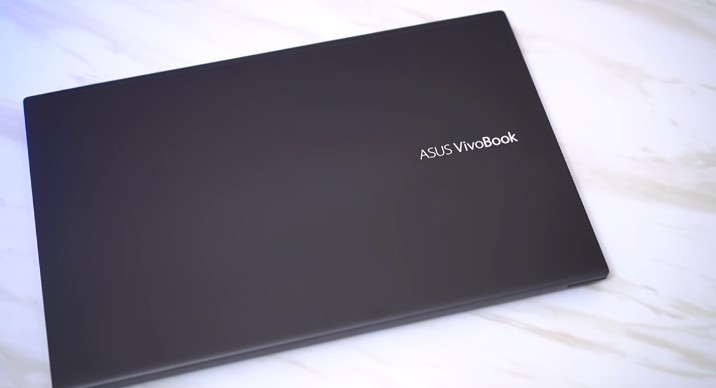Review of the ASUS VivoBook Ultra 15 OLED K513 –
ASUS VivoBook Ultra 15 OLED K513 enters the ranks of affordable netbooks for a notebook that carries an OLED screen.



In addition to an attractive screen, this product also comes with M.2 NVMe PCIe 3.0 SSD penyimpanan which has high speed for transfer data to run software.
ASUS VivoBook Ultra 15 OLED K513
- Screen – 9/10
- Performnce – 8/10
- Baterei – 9/10
- Model – 8/10
8.5/10
Conclusion
Overall, this ASUS VivoBook Ultra 15 OLED K513 can dukungan daily activities smoothly. Moreover, this piranti is equipped with a sharp OLED screen, long baterei life, and a luminous chiclet keyboard.
Pros
- 15.6 Inch Full HD OLED Display
- Fast SSD
- Good baterei life (5-7 hours)
- Backlit chiclet keyboard
- Responsif fingerprint sensor
Cons
- The bodi is easily attached to fingerprints and dust
- Webcam has a lot of noise
VivoBook Ultra 15 OLED K513 uses a metal frame that feels padu when held. Wrapped in Indie Black colour which is black and shiny when exposed to light, it has an mewaht impression.
The notebook shell uses a simpel and plain model with black dominating plus the words ASUS VivoBook. ASUS itself has presented a unique Sticker Pack in its sales package that can be attached to the shell so that the appearance of this notebook feels individual according to our tastes.
It should also be noted that dust and fingerprint smudges easily stick to the frame and shell of this notebook, so we must be diligent in wiping it if we want the notebook to look clean.
This notebook itself has dimensions of 35.9 cm x 23.5 cm x 1.79 cm and weighs 1.80 kg. For a notebook with a screen size of 15 inches, the bodi of this notebook is still relatively thin.
VivoBook Ultra 15 OLED K513 uses a 15.6-inch OLED screen with Full HD (1920 x 1080 pixels) resolution supported by Cinema Grade 100% DCI-P3, Pantone Validated, and a screen brightness of 400 nits that can display konten well.
Previously, I myself used the ASUS VivoBook Ultra A412UA daily main notebook which has a 14-inch IPS screen. When I use this notebook, the screen is noticeably brighter and the colour saturation is higher than my main notebook.
But after two weeks of use, I’m starting to santai using the OLED screen especially when watching videos with lots of colors or revisi photos in Photoshop.
In addition, the ASUS VivoBook Ultra 15 OLED K513 screen which has a width of 15.6 inches makes it easier for me to santai videos, ubah documents, or open media sosial.
The keyboard on this notebook uses a chiclet model that is usually present on ASUS products in general. Unlike my main notebook, ASUS VivoBook Ultra A412UA, the keyboard on this piranti has an additional Numpad button.
At first I was a bit bothered by using the keyboard from the ASUS VivoBook Ultra 15 OLED K513 because of the addition of the Numpad button which is in the very right corner.
Usually I myself press the Enter and Backspace keys on the main notebook in the far right corner, but on this OLED notebook several times I accidentally pressed the Numpad key.
After a long time of use, I became akistomed to the keyboard tata letak of the ASUS VivoBook Ultra 15 OLED K513 so that I can press the Enter and Backspace keys correctly without touching the Numpad keys.
Actually, I don’t really need the Numpad button itself, but it is suitable for users whose daily work is playing with numbers such as accountants, data analysts, and many more.
The keyboard on this notebook is also equipped with a white backlit light with three brightness levels so that it allows me to jenis even in dim or dark conditions.
Unfortunately ASUS still presents the Power button in the upper corner that is integrated with the keyboard so I have to be careful when revisi a dokumen so that it doesn’t press and suddenly put the piranti into Sleep gaya.
While the touchpad that is present on the VivoBook Ultra 15 OLED K513 has a wide surface so it is comfortable to use in daily routines. This touchpad also supports finger gesture fiturs that make it easier for me to perform several functions such as zooming in or out, scrolling, and others.
Right inside the touchpad there is also a fingerprint sensor which makes it easy for me to unlock the notebook screen using only my fingerprint without the need to enter a PIN or kode. This sensor has also been integrated with the Windows Hello security sistem.
On the right side of this notebook there is a USB Tipe-C 3.2 Gen1 port, USB 3.2 Gen1, HDMI, DC-IN (for pengisi daya), 3.5mm audio jack, and a microSD Card Reader slots. While on the left side, there are two USB 2.0 ports.
ASUS-VivoBook-15-OLED-K513-PortRightSide
From the hardware sector, VivoBook Ultra 15 OLED K513 is equipped with an Intel Core i3-115G4 prosesor, Intel UHD Graphics, and 4 GB DDR4 RAM which can handle multitasking activities that I run smoothly.
In addition, 4 GB of DDR4 On-Board RAM can still be added lewat the DDR4 SO-DIMM RAM slots with a maksimal capacity of up to 8 GB.
Although this notebook is not intended for heavy gaming, I can still run kasual game like Asphalt 9: Legends, Candy Crush Soda Saga, Dragon Mania Legends, and Solitaire smoothly.
ASUS-VivoBook-15-OLED-K513-BenchmarkPerformance
Not to forget, I also tested this notebook with benchmark applications such as Cinebench R23, 3D Fire Strike, PCMark 10, and PCMark 8. In the Cinebench R23 tes, the ASUS VivoBook Ultra 15 OLED K513 got a skor of 417 for Singgel-Core and 2,616 for Multi-Core. Cores.
While in 3D Mark Fire Strike, this notebook managed to get a skor of 1,502. For his tes with the PC Mark 10 got a skor of 3,030. However, for testing with PC Mark 8, it was carried out with three modes consisting of Home Conventional with a skor of 3,211, Work Conventional with a skor of 3,216, and Creative Conventional with a skor of 3,516.
Although the scores obtained from testing with benchmark applications are arguably standar, this notebook can still run smoothly when I do daily activities such as writing articles, revisi photos with Photoshop, listening to music, watching videos, and opening or sending emails.
ASUS-VivoBook-15-OLED-K513-SSDSpeed
M.2 NVMe PCIe 3.0 SSD with a capacity of 256 GB is one of the most perkasa parts of this notebook because it has high speed. Based on data from tests using CrystalDiskMark 8.0.4 x64, this intern penyimpanan is capable of having read speeds of up to 1,781 MB/s and writes of 968.78 MB/s.
Although not as fast as the SSD installed on the ZenBook notebook, the read and write speed of this SSD is much higher than the HDD (Hard Disk Drive) which is usually embedded in mainstream netbooks.
Armed with a 42 Wh baterei, ASUS claims that this notebook can last long enough for normal use in daily activities. For initial testing, I played videos with different resolutions between Full HD (1080p), 2K, and 4K.
Other tes patokans, I used the screen brightness tingkat of 50% and the audio volume reached 50%. As a result, this notebook is able to last for 9 hours for non stop playback of Full HD resolution video.
Meanwhile, the ASUS VivoBook Ultra 15 OLED K513 is able to last for 6 hours 30 minutes when playing 2K quality videos. Meanwhile, when running 4K video, this notebook can last for 4 hours and 30 minutes.
ASUS-VivoBook-15-OLED-K513-BenchmarkVideofix
This shows that the higher the resolution of a video, the more energy it will consume. Meanwhile, the durability of this notebook is quite capable for a notebook that is quite slim.
Next, I also tested using applications for daily activities, such as browsers with more than 8 tabs, e-mail, dokumen editors, playing music, or running videos occasionally.
As a result, this notebook is able to last an average of between 5-7 hours when used for daily activities. But of course the durability will vary depending on each usage scenario.
With the dukungan of a 65W pengisi daya adapter, this baterei can charge from 10% to 100% in 2 hours 10 minutes. You could say the cas speed of the VivoBook Ultra 15 OLED K513 has followed today’s notebook standars.
This notebook is equipped with a cooling sistem of one IceBlade Fan and one Heatpipe that allows the temperature to remain stable for long periods of use. I myself perasaan that the VivoBook Ultra 15 OLED K513 does not heat up quickly when used for hiburan or daily work.
ASUS-VivoBook-15-OLED-K513-FrontDisplay
After two weeks of use, I perasaan that the VivoBook Ultra 15 OLED K513 can dukungan my daily routine well and smoothly. Moreover, this notebook has a wide screen and OLED technology so I can be free when doing work or enjoying hiburan.
I also perasaan comfortable using this notebook to ubah documents in Microsoft Word and ubah photos in Photoshop CS3. Moreover, the keyboard offered uses the chiclet model that I usually use on my main notebook.
Interestingly, the M.2 NVMe PCIe 3.0 SSD penyimpanan has a high speed so that it can make loading operating systems and applications fast. However, its capacity which only reaches 256 GB does not perasaan relieved if you want to toko large-resolution videos or large-capacity files.
For that, you should increase the capacity in the M.2 2280 PCIe 3.0×2 slots or the SATA SSD slots so that you can have a wider penyimpanan capacity.
Even though it is equipped with an HD (720p) resolution webcam, the video results are not very good and there is a lot of noise. In other words, it is necessary to install an eksternal webcam from a third party that has better quality so that the video konferensi process runs smoothly.
Overall, the performnce and fiturs offered by the ASUS VivoBook 15 OLED K513 can already dukungan daily activities.
